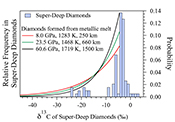 | Carbon isotopic signatures of super-deep diamonds mediated by iron redox chemistry Abstract: Among redox sensitive elements, carbon is particularly important because it may have been a driver rather than a passive recorder of Earth’s redox evolution. The extent to which the isotopic composition of carbon records the redox processes that shaped the Earth is still debated. In particular, the highly reduced deep mantle may be metal-saturated, however, it is still unclear how the presence of metallic phases influences the carbon isotopic compositions of super-deep diamonds. Here we report ab initio results for the vibrational properties of carbon in carbonates, diamond, and Fe3C under pressure and temperature conditions relevant to super-deep diamond formation. Previous work on this question neglected the effect of pressure on the equilibrium carbon isotopic fractionation between diamond and Fe3C but our calculations show that this assumption overestimates the fractionation by a factor of ~1.3. Our calculated probability density functions for the carbon isotopic compositions of super-deep diamonds derived from metallic melt can readily explain the very light carbon isotopic compositions observed in some super-deep diamonds. Our results therefore support the view that metallic phases are present during the formation of super-deep diamonds in the mantle below ~250 km. |
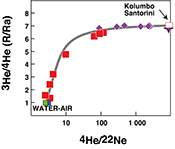 | New insights into the plumbing system of Santorini using helium and carbon isotopes Abstract: We have analysed He, Ne and CO2 concentrations and isotopic ratios in seawater samples collected using a ROV above hydrothermal fields and in CO2-accumulating pools within Santorini caldera (Greece). Our results provide new insights on the plumbing and magmatic sources of this volcano, which is critical to understand and better predict its volcanic eruptions, and its relationships to nearby volcanic systems. The 3He/4He ratio is as high as 6.54 times the atmospheric ratio, and significantly higher than any other samples from Santorini, including the active eruptive centre of Nea Kameni (~3.6 Ra). The 3He/4He ratio, corrected for atmospheric helium dissolved in seawater is ~7 Ra, a value similar to that measured at the nearby Kolumbo submarine volcano crater. The fluids display typical mantle signatures never recorded before in the active centres of the island of Santorini, in which fluids and gases are contaminated at shallow depths. The helium isotopic signature suggests that the source of volatiles for these two volcanoes is similar to the MORB source instead of being the subcontinental lithospheric mantle as suggested previously. |
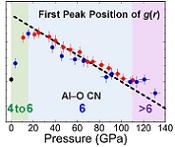 | Ultrahigh pressure structural changes in a 60 mol. % Al2O3-40 mol. % SiO2 glass Abstract: Structure of an Al-containing silicate glass (60 mol. % Al2O3–40 mol. % SiO2, A40S) is investigated up to 131 GPa, a pressure close to that of the Earth’s core-mantle boundary, by using our recently developed double stage large volume cell. The first peak (r1) of the pair distribution function, which corresponds to T–O distance (T = Al, Si), rapidly increases below 16 GPa, indicating an increase of average coordination number (CN) of T–O from ~4 to 6. The r1 linearly decreases in the pressure range of 25–110 GPa, but it displays a slope change and becomes nearly constant above 110 GPa. The slope change may imply a structural change in the A40S glass around 110 GPa, and may be explained by the change in Al–O distance associated with the Al–O CN increase from 6 to >6 as predicted by molecular dynamics simulations (Ghosh and Karki, 2018). Our observations suggest an important role for aluminum in densification of aluminosilicate at the deep lower mantle, which might imply a dense aluminosilicate magma with negative buoyancy. |
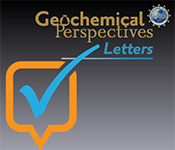 | Corrigendum to “Reorganisation of Earth’s biogeochemical cycles briefly oxygenated the oceans 520 Myr ago” by Dahl et al., 2017 |
 | Calcium stable isotopes place Devonian conodonts as first level consumers Abstract: Conodont animals are an extinct group of jawless vertebrates whose hard parts, also known as conodont elements, represent the earliest evidence of a mineralised skeleton in the vertebrate lineage. Conodont elements are interpreted as parts of a feeding apparatus, which together with the presence of eyes and microwear patterns, support the controversial hypothesis that conodont animals were macrophagous predators and/or scavengers. Here, we explore the trophic position of five conodont genera (Palmatolepis, Polygnathus, Ancyrodella, Ancyrognathus and Icriodus) from five contemporary Late Devonian sites distributed worldwide (France, Morocco, Vietnam and Australia) by means of calcium (Ca) stable isotope compositions. The seawater Ca isotope composition was calibrated using contemporary Late Devonian brachiopod isotopic values. By comparison with extant marine trophic chain composed of cartilaginous fish, conodont Ca isotope compositions are indicative of a zooplanktivore - primary piscivore niche, with no genus-specific trophic pattern. The question of active predation or scavenging cannot be resolved definitively but our results strongly suggest that Late Devonian conodonts were first level consumers. |
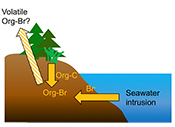 | Sea level rise produces abundant organobromines in salt-affected coastal wetlands Abstract: Global sea level rise exposes terrestrially derived natural organic matter to elevated salinities, which may alter the complex biogeochemical cycling of halogens in coastal wetland sediments. Here we show that sea level rise increases the natural production of organobromines in submerged soils and wetland sediments. We compared the concentrations and speciation of sedimentary chlorine and bromine along a salinity gradient in low-lying coastal forested wetlands in Winyah Bay (South Carolina, United States). Sorption differences between chloride and bromide were not observed, but up to 80 % of total retained bromine is organically bound, with the highest fraction of organically bound bromine found in formerly freshwater wetlands inundated by seawater. Wet/dry cycling of soils and the abundance of aromatic-rich natural organic matter in these salt-affected dieback forested wetlands promote bromination of organic matter, as demonstrated by laboratory simulations. Bromination of soil organic matter caused by continued sea level rise thus may be a major source of organobromines in coastal environments and possibly volatile halomethanes. |
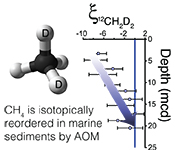 | Exchange catalysis during anaerobic methanotrophy revealed by 12CH2D2 and 13CH3D in methane Abstract: The anaerobic oxidation of methane (AOM) is a crucial component of the methane cycle, but quantifying its role in situ under dynamic environmental conditions remains challenging. We use sediment samples collected during IODP Expedition 347 to the Baltic Sea to show that relative abundances of 12CH2D2 and 13CH3D in methane remaining after microbial oxidation are in internal, thermodynamic isotopic equilibrium, and we attribute this phenomenon to the reversibility of the initial step of AOM. These data suggest that 12CH2D2 and 13CH3D together can identify the influence of anaerobic methanotrophy in environments where conventional bulk isotope ratios are ambiguous, and these findings may lead to new insights regarding the global significance of enzymatic back reaction in the methane cycle. |
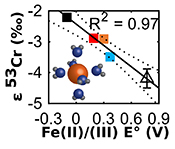 | Thermodynamic controls on redox-driven kinetic stable isotope fractionation Abstract: Stable isotope fractionation arising from redox reactions has the potential to illuminate the oxygenation of Earth’s interior, oceans, and atmosphere. However, reconstruction of past and present redox conditions from stable isotope signatures is complicated by variable fractionations associated with different reduction pathways. Here we demonstrate a linear relationship between redox-driven kinetic fractionation and the standard free energy of reaction for aqueous chromium(VI) reduction by iron(II) species. We also show that the intrinsic kinetic fractionation factor is log-linearly correlated with the rate constant of reaction, which is in turn a function of the free energy of reaction. The linear free energy relationship for kinetic fractionation describes both our experimental results and previous observations of chromium isotope fractionation and allows the magnitude of fractionation to be directly linked to environmental conditions such as pH and oxygen levels. By demonstrating that the magnitude of kinetic fractionation can be thermodynamically controlled, this study systematically explains the large variability in chromium(VI) isotope fractionation and provides a conceptual framework that is likely applicable to other isotope systems. |
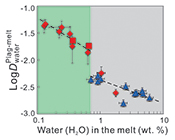 | A lunar hygrometer based on plagioclase-melt partitioning of water Abstract: The Moon was initially covered by a magma ocean. Hydrogen detected in plagioclase of ferroan anorthosites, the only available samples directly crystallised from the lunar magma ocean (LMO), can be used to quantify LMO hydrogen content. We performed experiments to determine plagioclase-melt partition coefficients of water under LMO conditions with water contents of co-existing plagioclase and melt quantified using Fourier-Transform Infrared Spectroscopy. Results indicate lunar plagioclase can incorporate approximately one order of magnitude more water than previously assumed. Using measured water contents of lunar plagioclase, this suggests that ~100 μg/g H2O equivalent was present in the residual magma when 95 % of the initial LMO had crystallised. Our results constrain initial LMO water contents to ~ 5 μg/g H2O equivalent if water was conserved throughout LMO evolution. If on the other hand the initial LMO contained >1000 μg/g water as suggested by experiments on LMO crystallisation, >99 % hydrogen degassing occurred during the evolution of the LMO. |
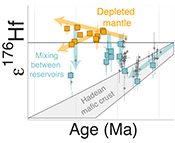 | Onset of new, progressive crustal growth in the central Slave craton at 3.55 Ga Abstract: Ancient rock samples are limited, hindering the investigation of the processes operative on the Earth early in its history. Here we present a detailed study of well-exposed crustal remnants in the central Slave craton that formed over a 1 billion year magmatic history. The tonalitic-granodioritic gneisses analysed here are broadly comparable to common suites of rocks found in Archean cratons globally. Zircon Hf isotope data allow us to identify a major change in the way continental crust was formed in this area, with a shift to distinctly positive εHf starting at ~3.55 Ga. The crust production processes and spatial distribution of isotopic compositions imply variable interaction with older crust, similar to the relationships seen in modern tectonic settings; specifically, long-lived plate margins. A majority of the Slave craton might have been formed by a similar mechanism. |
 | Corrigendum to “Plume-lithosphere interaction, and the formation of fibrous diamonds” by Broadley et al., 2018 |
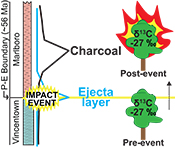 | Widespread and intense wildfires at the Paleocene-Eocene boundary Abstract: Discovery of impact spherules associated with the onset of the Carbon Isotope Excursion (CIE) that marks the Paleocene-Eocene (P-E) boundary (~56 Ma) indicates that the P-E transition was coincident with an extraterrestrial impact. Charcoal abundances increase >20 times background immediately above the P-E spherule layer at two Atlantic Coastal Plain palaeo-continental shelf localities located >200 km apart. Individual charcoal shards (~100 μm long; 58-83 wt. % carbon) show charred plant features. The carbon isotope ratio of charcoal (δ13Ccharcoal) through the peak shows that it originated from pre-impact vegetation that burned. We consider two scenarios to explain this widespread, synchronous increase in charcoal at the P-E boundary: 1) warming-induced, continental-scale drying; and 2) impact-induced wildfires. Differentiating between these two hypotheses depends critically on the observed sequence of events, which on the western North Atlantic margin is: the impact spherule horizon, followed by the peak in charcoal (derived from vegetation that grew before the CIE and impact), and finally the nadir of the CIE. Importantly, the pre-excursion δ13Ccharcoal remains constant through the CIE onset, requiring a dramatic increase in sedimentation. This work clarifies our understanding of the timing and sequence of events following an extraterrestrial impact at the P-E boundary. |
<< Previous issueNext issue >>





